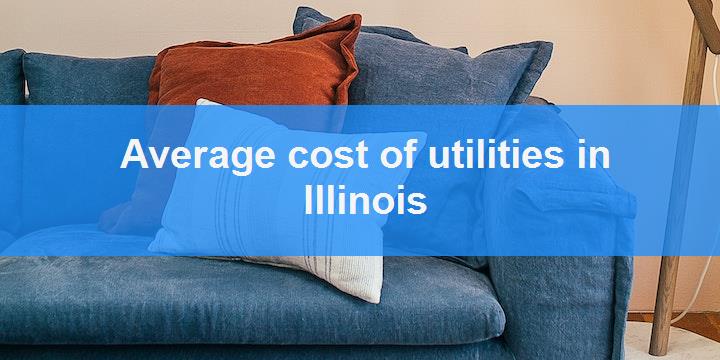Exploring the average cost of utilities in Utah is essential for residents who want to budget wisely. For a family of three living in a single-family home with standard appliances used year-round, the average cost of utilities in Utah is $520.05 in 2025. Utah’s diverse climate—ranging from hot, arid summers to cold, snowy winters—plays a significant role in shaping utility expenses. In this guide, I’ll break down the key utility costs across seasons and household setups, giving you a comprehensive understanding of what to expect in Utah.
Average Electric Bill in Utah
When it comes to managing household budgets, electricity costs are a major factor. The average electric bill in Utah is $113.97 in 2025 for a family of three living in a single-family home. Utah’s climate extremes—from scorching summer highs to chilly winter lows—directly impact electricity usage, especially for heating and cooling systems.
The average electric bill is calculated based on seasonal consumption patterns, including both winter ($137.05) and summer usage ($90.88). This provides a realistic snapshot of year-round expenses.
Utah vs. Colorado: A Comparative Look at Summer Energy Costs
Curious about how Utah stacks up against its neighbor? The table below compares electricity expenses for a large single-family home with four people during the summer in Utah and Colorado. This side-by-side comparison highlights the impact of climate, energy sources, and efficiency measures on household electricity costs.
| Criteria | Utah | Colorado |
|---|---|---|
| Total Consumption (kWh) | 862.12 kWh | |
| Electricity Rate (cents/kWh) | 11.26 ¢/kWh | 15.02 ¢/kWh |
| Estimated Monthly Cost | $97.07 | $129.49 |
| Detailed Cost Breakdown | ||
| Base Usage: 412.12 kWh | $46.40 | $61.90 |
| Refrigerator: 120 kWh | $13.51 | $18.02 |
| Air Conditioner: 240 kWh | $27.02 | $36.05 |
| Clothes Dryer: 90 kWh | $10.13 | $13.52 |
| Utah estimated monthly cost is lower than Colorado by 25.04%. | ||
Historical Trends in Summer Electricity Prices
The historical chart above showcases how electricity prices in Utah have evolved over time, particularly during the high-demand summer months. Tracking these trends can offer valuable insights into future cost fluctuations and help with long-term budgeting strategies.
Electricity Costs Across Various States
This table compares the electric costs across different states, considering various household types and seasons. It offers a comprehensive view of utility expenses.
| State | People | Household Type | Season | Appliances | Electric Monthly Bill |
|---|---|---|---|---|---|
| New York | 3 | One-bedroom apartment | Summer | Fridge, AC, Dryer |
$148.77 |
| California | 4 | Single-family large | Winter | Heater, Dryer, Fridge |
$407.08 |
| Texas | 3 | Townhouse | Winter | Heater, Dryer, Fridge |
$168.56 |
| Florida | 3 | Single-family small | Summer | Fridge, AC, Washer |
$102.05 |
| Illinois | 4 | Two-bedroom apartment | Summer | Fridge, AC, Washer |
$99.77 |
| Georgia | 2 | Studio | Winter | Heater, Fridge |
$123.20 |
| Utah | 2 | Townhouse | Summer | Fridge, AC, Washer |
$74.60 |
For a more detailed and personalized utility expense estimate, visit our Electricity Bill Calculator. Adjust the parameters to match your household specifics and get an accurate estimate tailored to your needs.
Average Gas Bill in Utah
Effectively managing household expenses starts with understanding key utility costs. For a family of three living in a single-family home, the average gas bill in Utah is $144.76 in 2025. Given Utah’s climate—with cold winters and hot, dry summers—gas usage can fluctuate significantly throughout the year.
The average bill is calculated based on seasonal consumption patterns, factoring in both winter ($212.04) and summer usage ($77.48). This provides a realistic estimate of year-round gas expenses for Utah households.
Utah vs. Colorado: A Summer Gas Usage Comparison
How do Utah’s gas costs compare to those in neighboring states? The table below highlights the differences in gas expenses for a large single-family home with four people during the summer in Utah and Colorado. This comparison sheds light on how regional climate variations and household energy habits can influence costs.
Gas Bill Comparison Overview
| Criteria | Utah | Colorado | Avg. USA |
|---|---|---|---|
| Total Consumption (MCF) | 6.99 MCF | ||
| Gas Rate ($/MCF) | $13.24 | $12.35 | $17.73 |
| Estimated Monthly Cost | $92.58 | $86.35 | $123.97 |
| Appliance Cost Breakdown | |||
| Outdoor Grill | $7.31 | $6.82 | $9.79 |
| Water Heater | $53.60 | $49.99 | $71.77 |
| Gas Stove | $12.18 | $11.36 | $16.31 |
| Gas Oven | $19.49 | $18.18 | $26.10 |
| Utah's estimated monthly cost is higher than Colorado by 7.21%. | |||
| Utah's estimated monthly cost is lower than the Avg. USA by 25.32%. | |||
By comparing gas usage between Utah and Colorado, you can better understand how factors like temperature swings and household size impact energy costs. This insight is especially useful when budgeting for seasonal changes.
The historical chart above illustrates gas price trends for large single-family homes in Utah, particularly during the high-demand summer months. Tracking these trends over time provides valuable insights into price fluctuations, helping you anticipate future costs and adjust your budget accordingly.
Gas Cost Comparison Across Various States
Here is a detailed comparison of gas costs across different states, considering various household types and seasons. This table offers a comprehensive view of utility expenses.
| State | People | Household Type | Season | Appliances | Gas Monthly Bill |
|---|---|---|---|---|---|
| New York | 3 | Townhouse | Summer | Water heater, Stove, Oven |
$88.71 |
| Florida | 2 | Studio | Summer | Water heater, Stove, Oven |
$82.41 |
| Vermont | 4 | Single-family small | Winter | Gas heating, Dryer, Oven |
$298.95 |
| Texas | 3 | Townhouse | Winter | Gas heating, Dryer, Oven |
$279.14 |
| Illinois | 3 | Single-family small | Summer | Water heater, Stove, Oven |
$79.83 |
| South Carolina | 4 | Single-family large | Summer | Water heater, Stove, Oven |
$134.85 |
| Michigan | 2 | Studio | Winter | Gas heating, Dryer, Oven |
$99.20 |
This comparison table offers a broad perspective on how gas costs vary across different states and household setups, helping you make more informed decisions about your energy usage.
For a detailed and personalized utility expense estimate, explore our Gas Bill Calculator. Customize the parameters to fit your household specifics and get an accurate estimate tailored to your needs.
Average Water Bill in Utah
Considering a move or investment in Utah? One key factor to evaluate is the cost of utilities, particularly water and sewer fees. In 2025, the average amount for water and sewer fees in Utah is $58.00, making it a budget-friendly option compared to many neighboring states.
Comparative Look: How Does Utah Stack Up?
To offer a broader perspective, here’s a comparison of Utah’s water and sewer fees with those in eight other states:
| State | Average Water and Sewer Fees |
|---|---|
| Arizona | $64.00 |
| Nevada | $46.00 |
| Colorado | $39.00 |
| Idaho | $48.00 |
| Wyoming | $73.00 |
| New Mexico | $62.00 |
| California | $77.00 |
| Oregon | $76.00 |
As seen above, Utah’s fees are competitive, especially when compared to higher-cost states like California and Nevada, where water scarcity often drives up prices.
Smart Water Management Techniques for Utah Residents
Given Utah’s arid climate, efficient water management is not just eco-friendly—it’s essential. Here are some effective strategies to reduce water consumption:
- Desert Landscaping (Xeriscaping): Utilize drought-resistant plants that thrive with minimal water, reducing outdoor irrigation needs.
- Smart Irrigation Systems: Install automated systems that adjust watering schedules based on real-time weather conditions, saving both water and money.
- Greywater Recycling: Repurpose water from sinks, showers, and laundry for irrigation, significantly lowering overall consumption.
- Rainwater Harvesting: Collect and store rainwater for garden use, maximizing natural resources even in drier seasons.
Local Resources and Incentives
Utah offers a range of support programs to encourage water conservation. Homeowners can benefit from:
- Rebates for Water-Efficient Appliances: Save on costs when upgrading to eco-friendly dishwashers, washing machines, and low-flow toilets.
- Incentives for Sustainable Landscaping: Financial support for implementing water-saving landscape designs and irrigation systems.
- Community Workshops: Learn best practices for water conservation through local programs and educational resources.
Environmental Impact of Water Conservation
Adopting sustainable water practices doesn’t just reduce your utility bills—it helps preserve Utah’s precious natural resources. By using water wisely, residents contribute to healthier ecosystems, improved drought resilience, and the long-term sustainability of the state’s water supply.
Conclusion: Why Utah Stands Out
Drawing from my extensive experience in real estate, I can confidently say that Utah’s reasonable water and sewer fees, combined with forward-thinking conservation strategies and strong community support, make it an ideal choice for both homeowners and investors. Our team is here to guide you with expert advice, ensuring you make well-informed decisions. Choosing Utah means embracing a state that values both cost-efficiency and environmental stewardship.
Garbage/Trash Removal Costs in Utah
Managing garbage and trash removal costs is an important part of household budgeting in Utah. The average cost for garbage and trash removal services in Utah in 2025 is around $24.00. These costs can vary depending on factors like the service provider, the frequency of pick-ups, and whether recycling services are included.
Utah’s waste management practices differ significantly between urban areas like Salt Lake City and more rural regions. Cities often offer curbside recycling and composting programs, while rural areas may rely on private waste management services. These variations can impact the overall cost of garbage removal.
Garbage/Trash Removal Costs Comparison Across States
To provide a comprehensive view, here’s a comparison of Utah’s average garbage/trash removal costs with those of other states:
- Nevada: $29.00
- Arizona: $25.00
- Colorado: $28.00
- Idaho: $27.00
- Wyoming: $25.00
- Montana: $25.00
- New Mexico: $25.00
- Oregon: $30.00
- Washington: $30.00
- California: $35.00
From this comparison, it’s evident that Utah’s garbage removal costs are relatively moderate, especially compared to states like California and Washington, where extensive urban infrastructure can drive up costs.
Understanding these expenses is crucial for managing your household budget effectively. If you need further assistance navigating your utility costs in Utah, our team is here to help.
Internet and Cable TV Expenses in Utah
When planning your household budget in Utah, internet and cable TV costs are essential factors to consider. The average internet and cable TV expenses in Utah in 2025 are around $113.66. Living in the Beehive State, I’ve observed that these costs can vary depending on the provider and specific location.
Utah offers a diverse range of internet and cable TV providers, ensuring residents have multiple options. This competition helps maintain high service quality while keeping prices competitive, whether you’re in Salt Lake City or a rural area.
Price Comparison of Providers in Utah
| Provider | Internet Price | Cable TV Price | Bundle Price |
|---|---|---|---|
| Comcast | $59.99 | $70.99 | $114.99 |
| Verizon | $60.99 | $71.99 | $121.99 |
| AT&T | $55.99 | $66.99 | $103.99 |
These providers offer a range of packages, so it’s essential to compare their plans to find the best option that fits your needs and budget.
Internet and Cable TV Costs Comparison Across States
To offer a broader perspective, here’s how Utah’s average internet and cable TV expenses compare with those of neighboring states:
- Colorado: $113.66
- Nevada: $116.32
- Arizona: $112.66
- New Mexico: $112.66
- Wyoming: $112.66
- Idaho: $112.66
- California: $116.32
- Montana: $112.66
Utah’s costs are relatively competitive, especially compared to states like California and Colorado, where service fees tend to be higher. This underscores the importance of comparing different providers to secure the best deal.
To get the most value from your internet and cable TV services, we recommend evaluating various providers and packages. By doing so, you can find a plan that balances cost, speed, and service quality to meet your specific needs.
Home Phone and Mobile Phone Expenses in Utah
When it comes to managing household budgets in Utah, keeping track of communication costs is key. The average home phone and mobile phone costs in Utah in 2025 are around 65.66. These expenses can vary based on your service provider, plan type, and location within the Beehive State.
Utah offers a wide range of phone service providers, from major national carriers to regional companies. This variety fosters healthy competition, helping to keep prices affordable while maintaining reliable service quality.
Provider Pricing Breakdown in Utah
| Provider | Mobile Phone Price | Home Phone Price |
|---|---|---|
| Verizon | $70.99 | $37.99 |
| AT&T | $65.99 | $30.99 |
| T-Mobile | $59.99 | Doesn’t provide home phone services |
These prices provide a snapshot of the options available, allowing you to choose the plan that best fits your needs and budget.
State-by-State Cost Comparison
To offer a broader perspective, here’s how Utah’s average home phone and mobile phone expenses compare with those of neighboring states:
- Colorado: 63.66
- Nevada: 64.66
- Arizona: 64.66
- Idaho: 68.32
- Wyoming: 66.66
- Montana: 63.66
- New Mexico: 63.66
- California: 66.66
Compared to states like Colorado and Nevada, Utah’s phone costs are relatively moderate, making it an attractive option for budget-conscious residents. This comparison highlights the importance of evaluating providers not just locally, but regionally, to secure the best rates.
Maximizing Value for Your Money
To ensure you’re getting the most from your home and mobile phone services, consider the following tips:
- Compare Plans Regularly: Providers frequently update their offerings, so reviewing your plan annually can help you spot potential savings.
- Bundle Services: Bundling mobile with internet or TV can often lead to discounts.
- Negotiate with Providers: Don’t hesitate to negotiate your rates, especially if you’ve been a long-term customer.
In conclusion, regularly reviewing and comparing phone service providers can significantly reduce your overall expenses. Staying updated on the latest deals and offers ensures you’re not overpaying for essential services. Our team updates this article monthly with the latest rates and information, so check back frequently for fresh insights. 🌟
FAQ
Q: 💡 What is the average monthly electric bill in Utah in 2025?
A: The average monthly electric bill for Utahns in 2025 is approximately $113.97.
Q: 🔥 What is the average monthly gas bill for Utahns in 2025?
A: The average monthly gas bill for Utahns in 2025 stands at approximately $144.76.
Q: 🚰 What is the average monthly water and sewer bill in Utah in 2025?
A: The average monthly water and sewer bill in Utah in 2025 is around $58.00.
Q: 🗑️ What is the average monthly garbage and trash removal cost in Utah in 2025?
A: The average monthly garbage and trash removal cost in Utah in 2025 is about $24.00.
Q: 📡 What is the average monthly internet and cable TV bill in Utah in 2025?
A: The average monthly internet and cable TV bill in Utah in 2025 is approximately $113.66.
Q: 📱 What is the average monthly home and mobile phone bill in Utah in 2025?
A: The average monthly home and mobile phone bill in Utah in 2025 is around 65.66.
Q: 🧾 What is the total average monthly cost of utilities in Utah in 2025?
A: The total average monthly cost of utilities in Utah in 2025 is approximately $520.05.



